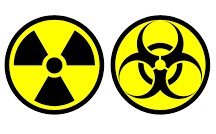25 March 2021
The Palomares Incident.
Nuclear bombs, nuclear power – and oranges.
By Neil Tidmarsh
 Hiroshima, Japan, 6 August 1945; Nagasaki, Japan, 9 August 1945; Palomares, Spain, 17 January 1966.
Hiroshima, Japan, 6 August 1945; Nagasaki, Japan, 9 August 1945; Palomares, Spain, 17 January 1966.
Whoops, that was a mistake. No, not my mistake. The US Air Force’s mistake. They really did drop an H-bomb (well, four H-bombs, actually) on the village of Palomares near Almería in 1966. But it was an accident. They didn’t mean to do it. Honest. Really sorry, buddy, but no hard feelings, huh?
There’s still uncertainty about how it actually happened. It seems that a B52 bomber was trying to re-fuel in mid-air but collided with the tanker aircraft. The bomber was carrying four nuclear missiles – ten-megaton H bombs, each one a hundred times more powerful than the ‘Little Boy’ which destroyed Hiroshima. Three fell into the fields around the seaside village and the fourth fell into the water just off-shore. Many of the aircrew from both planes died.
And there’s still uncertainty about why the bombs didn’t explode, particularly as one of them lost its safety catch. The three which fell on land were found and recovered quickly, but the one which fell into the Med was recovered only after fifteen US warships and two submarines had been searching for weeks. (A local fisherman, who saw where it fell and helped the US navy in the search, claimed salvage rights as one of the finders; his case went to the New York Federal court where he fought for twenty million dollars, one percent of the value of the object salvaged; the Pentagon settled out of court for an undisclosed sum.)
At least one of the bombs was damaged and leaked radioactive contamination into the fields. The USAF removed and disposed of masses of plutonium-contaminated soil in the following months, but surveys have proved that significant amounts of radioactive material remain there today. The contaminated area is still fenced off fifty-five years after the event and the Spanish and US governments are still arguing about how it should be decontaminated once and for all and who’s going to pay for it.
The incident was in the news this week because fresh research has revealed that it played a hitherto undisclosed role in the little-known story of Franco’s plan to create Spain’s own nuclear weapons (and no doubt it also takes on new life as a cautionary tale following last week’s publication of the Defence Review which recommends that the UK should increase its nuclear arsenal.)
The fascist dictator Franco positioned his country as an anti-Communist Cold War ally for the USA after World War II; he allowed the USA to build military bases in Spain in return for economic aid and technical know-how, in particular the building of nuclear power-stations. At the same time he was determined that Spain should develop its own atomic bomb. He appointed air force commander and nuclear physicist Guillermo Velarde as head of the Islero Project (named after the fighting bull which killed the famous matador Manolete in 1947) but apparently they made little progress until the Palomares incident happened to provide them with a technological breakthrough, according to a documentary film – A Nuclear Power – due to be broadcast this week on Discovery’s Spanish DMAX channel.
The film’s director, Josep Serra, has discovered from CIA files and from Guillermo Velarde’s memoirs that officials from the Islero Project managed to secretly grab debris from the Palomares crash – including fragments of the bombs – from under the noses of the Americans. The technological information gleaned from this debris gave the project a huge boost; they could now build the bomb – all they needed was plutonium for the warhead. And those new atomic power-stations could supply that, of course. But those power stations were being built with US dollars and US know-how, and Uncle Sam would be not happy, to say the least, if he found out they were being used to create nuclear warheads. Franco eventually decided not to risk antagonising his powerful ally, so the project had to wait until the 1970’s and a new power station was built near Tarragona with French rather than American help. But then the private companies running the station refused to take part in the plan. So the project began to build its own centre near Soria to extract plutonium from what remained of the Spanish nuclear power industry. But then Franco died in 1975 and Spain very quickly became a modern democratic state. The centre was never completed and the country abandoned the ambition to develop nuclear weapons.
It’s clear that Franco’s fascist regime came very close to developing its own atomic bomb. What effect would that have had on the Cold War and post-Cold War world? Would it have changed the history of modern Europe? Would it have ramped up the confrontation with the Communist East to even more dangerous levels? Would the fall of the Iron Curtain have been a more hazardous and violent business? Would Spain have been able to transition into a modern democracy on Franco’s death if his followers had had nuclear weapons up their sleeve?
But that’s all in the past, of course. What about the future? Well, there was another story in the news this week to act as a cheering epilogue to this murky tale, a much-needed reminder that the twenty-first century world into which we are moving is much more sensible and civilised than the twentieth century world which we’re leaving behind.
Spain has abandoned atomic weapons and it now seems that it’s abandoning atomic power too. It has apparently found a new, fresher, juicier, more wholesome source of energy.
Seville is famous for its oranges, the bitter fruit which is the defining and exclusive ingredient in our marmalade. There are over 50,000 orange trees in the city, lining its every street, and every year they produce almost half a million tonnes of fruit. But only a fraction of that harvest is exported to the UK to make marmalade; the rest – too bitter to eat – has to be cleared from the streets and sent to the rubbish dump in a disposal operation which costs millions of euros.
But the municipal water company Emasesa has started to use the oranges and other organic waste to produce biogas. The biogas is burned to produce electricity, and the electricity is used to power the city’s water purification plants – Andalucía’s biggest purification plant will soon be self-sufficient in energy. And it’s thought that Seville’s entire orange crop could also supply almost 100,000 homes with electricity. And vehicles could use the biogas for fuel.
Nuclear power and nuclear weapons? So last century. The future is bright – the future is orange.


